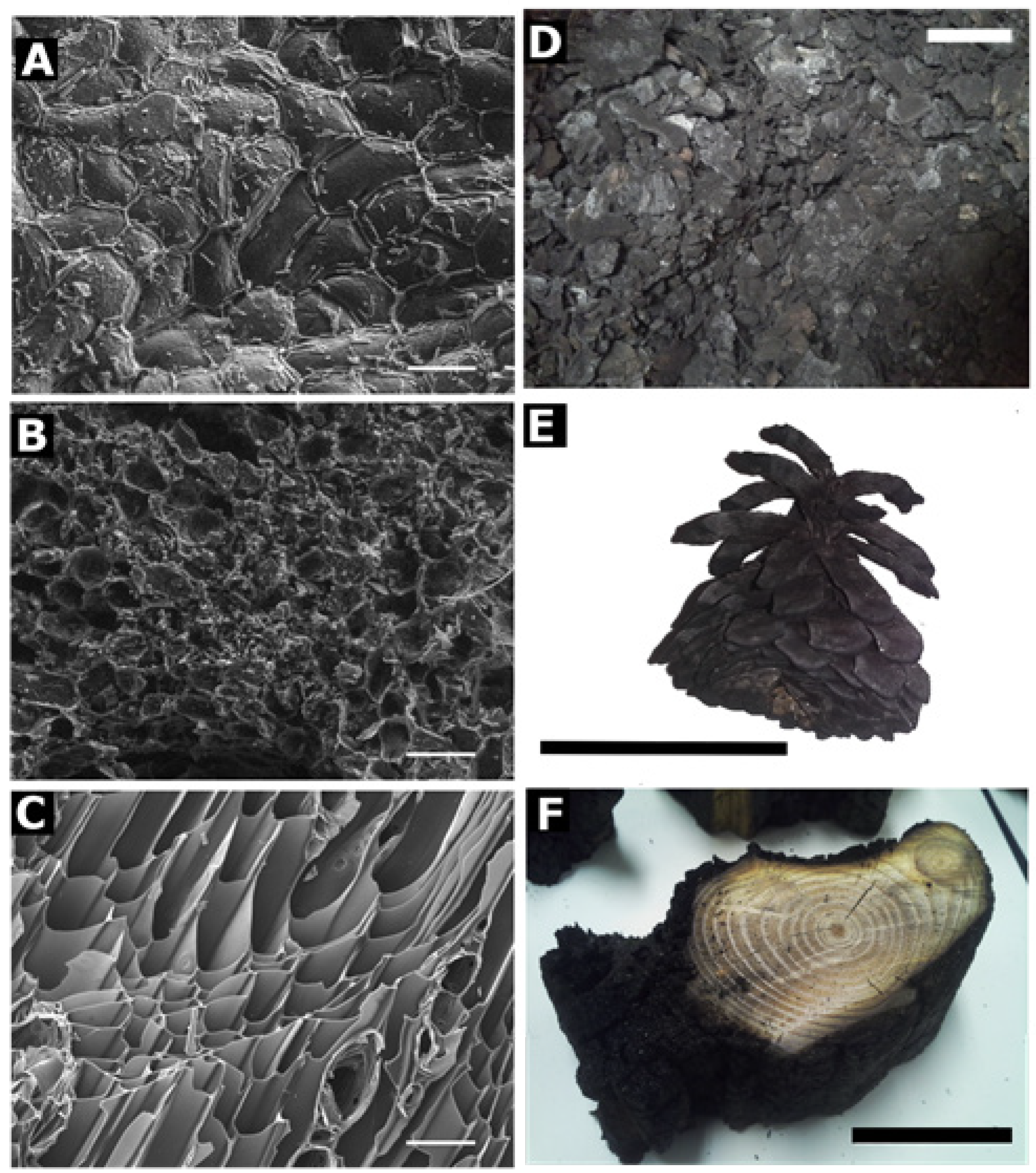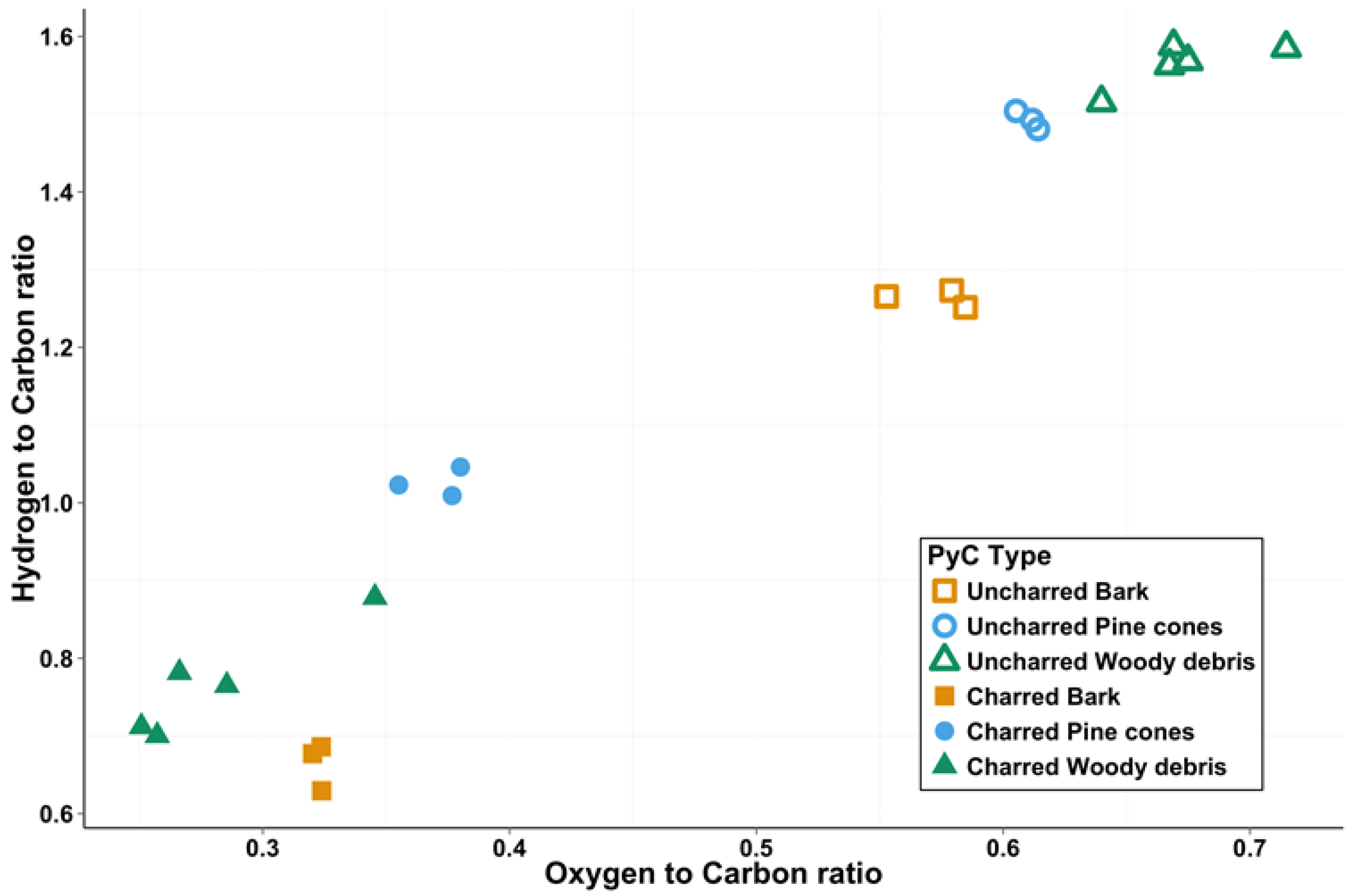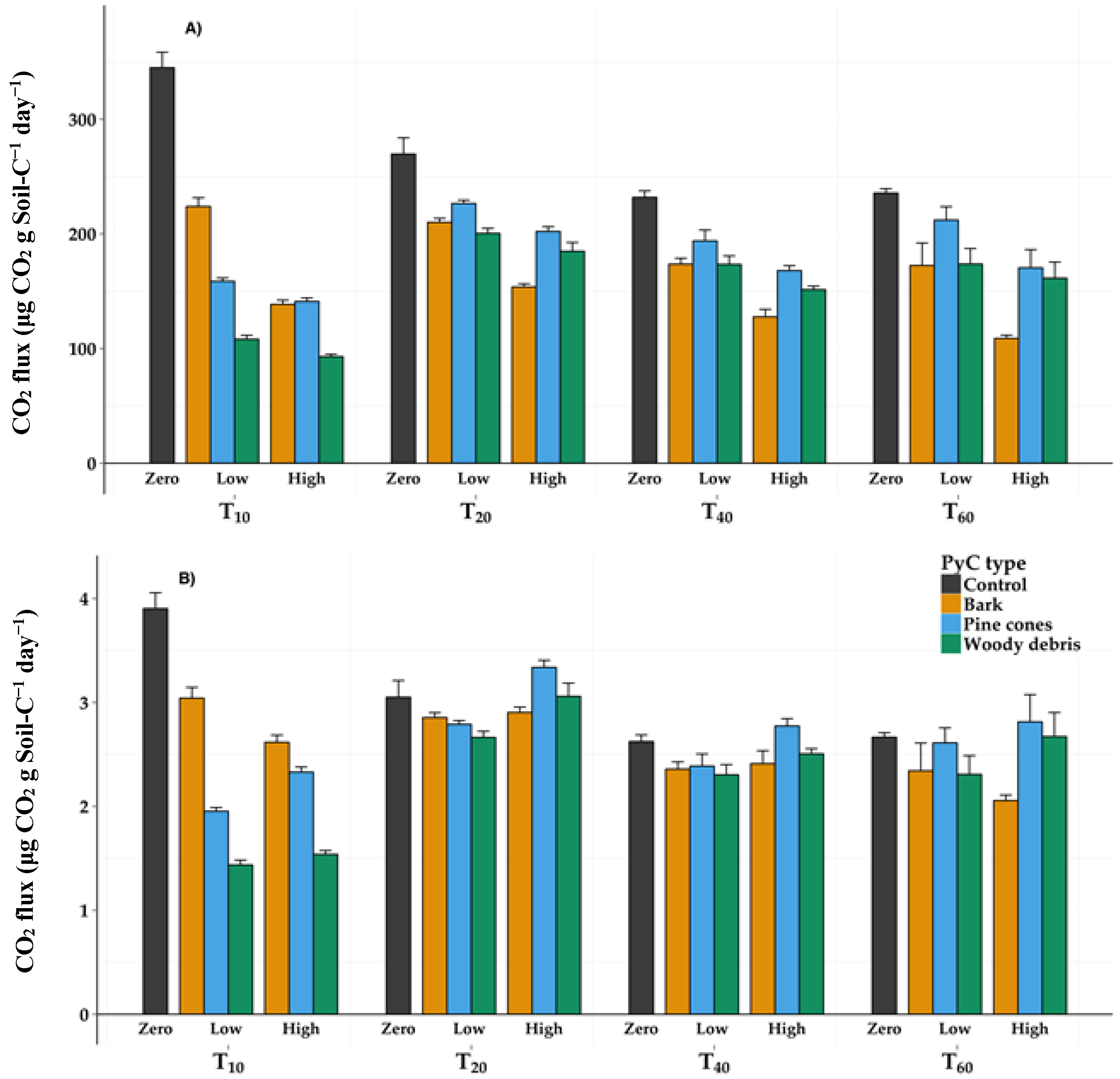Source Material and Concentration of Wildfire-Produced Pyrogenic Carbon Influence Post-Fire Soil Nutrient Dynamics
Abstract
:1. Introduction
2. Experimental Section
2.1. Study Site and Sample Collection

2.2. Laboratory Analysis
2.3. Laboratory Incubations
2.4. Statistical Analysis
3. Results
3.1. Chemical Composition

| Material | n | %C | %H * | %N * | %O | %Ash | O/C | H/C | C/N * | pH |
|---|---|---|---|---|---|---|---|---|---|---|
| Charred | ||||||||||
| BK | 3 | 50.22 ± 0.43 a | 33.34 ± 0.60 ab | 0.23 ± 0.01 a | 16.20 ± 0.17 a | 1.40 ± 0.19 ab | 0.32 ± 0.00 ab | 0.66 ± 0.018 b | 214.97 ± 8.68 ab | 4.4 ± 0.0 |
| PC | 3 | 41.62 ± 0.25 b | 42.70 ± 0.26 a | 0.25 ± 0.01 ab | 15.43 ± 0.27 ab | 8.54 ± 0.6 a | 0.37 ± 0.01 a | 1.03 ± 0.011 a | 169.83 ± 5.39 a | 3.8 ± 0.0 |
| WD | 5 | 48.83 ± 1.10 a | 37.34 ± 0.67 b | 0.18 ± 0.01 b | 13.65 ± 0.50 b | 1.77 ± 0.41 b | 0.28 ± 0.01 b | 0.77 ± 0.032 b | 272.27 ± 17.06 b | 4.3 ± 0.0 |
| Uncharred | ||||||||||
| Bark | 3 | 35.20 ± 0.12 a | 44.46 ± 0.22 a | 0.20 ± 0.01 a | 20.14 ± 0.30 ab | 1.39 ± 0.12 a | 0.57 ± 0.01 a | 1.26 ± 0.01 a | 175.87 ± 7.17 ab | 3.7 ± 0.0 |
| Pine cones | 3 | 32.14 ± 0.05 b | 47.97 ± 0.15 b | 0.27 ± 0.00 b | 19.62 ± 0.11 a | 1.02 ± 0.18 a | 0.61 ± 0.00 a | 1.49 ± 0.01 b | 118.53 ± 1.42 b | 3.5 ± 0.0 |
| Woody debris | 5 | 30.85 ± 0.22 c | 48.24 ± 0.14 b | 0.15 ± 0.01 c | 20.76 ± 0.23 b | 1.00 ± 0.13 a | 0.67 ± 0.01 b | 1.56 ± 0.01 c | 219.67 ± 20.89 a | 3.7 ± 0.0 |
3.2. Incubations
3.2.1. CO2 Flux (in Terms of Soil-C)

| Main Effect | F Value | p Value | |
|---|---|---|---|
| μg CO2 g soil-C−1 day−1 | Treatment | 87.81 | <0.0001 |
| Time | 55.08 | <0.0001 | |
| Treatment × Time | 30.65 | <0.0001 | |
| μg CO2 g soil−1 day−1 | Treatment | 18.58 | <0.0001 |
| Time | 79.38 | <0.0001 | |
| Treatment × Time | 32.58 | <0.0001 |
3.2.2. CO2 Flux (in Terms of g Soil)
3.2.3. Nitrogen Flux

| PyC Type | |||||
|---|---|---|---|---|---|
| Time | Concentration | Control | BK | PC | WD |
| 20 | Zero | 0.33 ± 0.03 c | — | — | — |
| Low | — | 0.40 ± 0.01 d | 0.33 ± 0.03 c | 0.36 ± 0.03 cd | |
| High | — | 0.31 ± 0.03 bc | 0.17 ± 0.12 abc | 0.23 ± 0.02 bc | |
| 40 | Zero | 0.11 ± 0.12 abc | — | — | — |
| Low | — | -0.17 ± 0.16 a | 0.26 ± 0.04 bc | 0.27 ± 0.01 bc | |
| High | — | 0.24 ± 0.04 bc | 0.08 ± 0.02 ab | 0.21 ± 0.02 abc | |
| 60 | Zero | 0.24 ± 0.04 bc | — | — | — |
| Low | — | 0.22 ± 0.00 bc | 0.22 ± 0.01 bc | 0.20 ± 0.02 abc | |
| High | — | 0.22 ± 0.01 abc | 0.15 ± 0.03 abc | 0.18 ± 0.03 abc |
| Main Effect | F Value | p Value | |
|---|---|---|---|
| Ammonification | Treatment | 3.26 | 0.0101 |
| Time | 24.77 | <0.0001 | |
| Treatment × Time | 3.15 | 0.0029 | |
| Nitrification | Treatment | 1.47 | 0.2108 |
| Time | 10.22 | 0.0002 | |
| Treatment × Time | 0.43 | 0.9437 | |
| N mineralization | Treatment | 3.96 | 0.0032 |
| Time | 18.94 | <0.0001 | |
| Treatment × Time | 2.95 | 0.0047 |
4. Discussion
5. Conclusions
Acknowledgments
Author Contributions
Conflicts of Interest
References
- Pechony, O.; Shindell, D.T. Driving forces of global wildfires over the past millennium and the forthcoming century. Proc. Natl. Acad. Sci. USA 2010, 107, 19167–19170. [Google Scholar] [CrossRef] [PubMed]
- Van Mantgem, P.J.; Nesmith, J.C.; Keifer, M.; Knapp, E.E.; Flint, A.; Flint, L. Climatic stress increases forest fire severity across the western United States. Ecol. Lett. 2013, 16, 1151–1156. [Google Scholar] [CrossRef] [PubMed]
- Lehmann, J.; Rillig, M.C.; Thies, J.; Masiello, C.A.; Hockaday, W.C.; Crowley, D. Biochar effects on soil biota—A review. Soil Biol. Biochem. 2011, 43, 1812–1836. [Google Scholar] [CrossRef]
- Ameloot, N.; Graber, E.R.; Verheijen, F.G.A.; De Neve, S. Interactions between biochar stability and soil organisms: Review and research needs. Eur. J. Soil Sci. 2013, 64, 379–390. [Google Scholar] [CrossRef]
- Schmidt, M.W.I.; Noack, A.G. Black carbon in soils and sediments: Analysis, distribution, implications, and current challenges. Global Biogeochem. Cy. 2000, 14, 777–793. [Google Scholar] [CrossRef]
- Norwood, M.J.; Louchouarn, P.; Kuo, L.J.; Harvey, O.R. Characterization and biodegradation of water-soluble biomarkers and organic carbon extracted from low temperature chars. Org. Geochem. 2013, 56, 111–119. [Google Scholar] [CrossRef]
- Maestrini, B.; Nannipieri, P.; Abiven, S. A meta-analysis on pyrogenic organic matter induced priming effect. GCB Bioenerg. 2014. [Google Scholar] [CrossRef]
- Zimmerman, A.R. Abiotic and microbial oxidation of laboratory-produced black carbon (biochar). Environ. Sci. Technol. 2010, 44, 1295–1301. [Google Scholar] [CrossRef] [PubMed]
- Knicker, H. How does fire affect the nature and stability of soil organic nitrogen and carbon? A review. Biogeochemistry 2007, 85, 91–118. [Google Scholar] [CrossRef]
- DeLuca, T.H.; MacKenzie, M.D.; Gundale, M.J.; Holben, W.E. Wildfire-produced charcoal directly influences nitrogen cycling in ponderosa pine forests. Soil Sci. Soc. Am. J. 2006, 70, 448–453. [Google Scholar] [CrossRef]
- Zackrisson, O.; Nilsson, M.C.; Wardle, D.A. Key ecological function of charcoal from wildfire in the boreal forest. Oikos 1996, 77, 10–19. [Google Scholar] [CrossRef]
- Santín, C.; Doerr, S.H.; Preston, C.M.; González-Rodríguez, G. Pyrogenic organic matter production from wildfires: A missing sink in the global carbon cycle. Glob. Chang. Biol. 2015, 21, 1621–1633. [Google Scholar] [CrossRef] [PubMed]
- Soucémarianadin, L.N.; Quideau, S.A.; MacKenzie, M.D.; Bernard, G.M.; Wasylishen, R.E. Laboratory charring conditions affect black carbon properties: A case study from quebec black spruce forests. Org. Geochem. 2013, 62, 46–55. [Google Scholar] [CrossRef]
- Preston, C.M.; Schmidt, M.W.I. Black (pyrogenic) carbon: A synthesis of current knowledge and uncertainties with special consideration of boreal regions. Biogeosciences 2006, 3, 397–420. [Google Scholar] [CrossRef] [Green Version]
- McBeath, A.V.; Smernik, R.J. Variation in the degree of aromatic condensation of chars. Org. Geochem. 2009, 40, 1161–1168. [Google Scholar] [CrossRef]
- McBeath, A.V.; Smernik, R.J.; Schneider, M.P.W.; Schmidt, M.W.I.; Plant, E.L. Determination of the aromaticity and the degree of aromatic condensation of a thermosequence of wood charcoal using NMR. Org. Geochem. 2011, 42, 1194–1202. [Google Scholar] [CrossRef]
- Lehmann, J.; Abiven, S.; Kleber, M.; Pan, G.; Singh, B.P.; Sohi, S.P.; Zimmerman, A.R. Persistence of biochar in soil. In Biochar for Environmental Management: Science, Technology and Implementation, 2nd ed.; Lehmann, J., Joseph, S., Eds.; Earthscan: London, UK, 2015; pp. 233–280. [Google Scholar]
- McBeath, A.V.; Smernik, R.J.; Krull, E.S. A demonstration of the high variability of chars produced from wood in bushfires. Org. Geochem. 2013, 55, 38–44. [Google Scholar] [CrossRef]
- Simard, A.J.; Blank., R.W. Fire history of a Michigan jack pine forest. Mich. Acad. 1982, 15, 59–71. [Google Scholar]
- Hammond, J.; Shackley, S.; Prendergast-Miller, M.; Cook, J.; Buckingham, S.; Pappa, V.A. Biochar field testing in the UK: Outcomes and implications for use. Carbon Manag. 2013, 4, 159–170. [Google Scholar] [CrossRef]
- Miller, J.D.; Safford, H. Trends in wildfire severity: 1984 to2010 in the Sierra Nevada, Modoc Plateau, and southern cascades, California, USA. Fire Ecol. 2012, 8, 41–57. [Google Scholar] [CrossRef]
- NOAA. National Climatic Data Center. Available online: http://www.ncdc.noaa.gov (accessed on 22 March 2015).
- Werlein, J.O. Soil Survey of Crawford County, Michigan; USDA Natural Resources Conservation Service and USDA Forest Service: Washington, DC, USA, 1998; p. 274.
- Abiven, S.; Hengartner, P.; Schneider, M.P.W.; Singh, N.; Schmidt, M.W.I. Pyrogenic carbon soluble fraction is larger and more aromatic in aged charcoal than in fresh charcoal. Soil Biol. Biochem. 2011, 43, 1615–1617. [Google Scholar] [CrossRef]
- Castaldi, S.; Riondino, M.; Baronti, S.; Esposito, F.R.; Marzaioli, R.; Rutigliano, F.A.; Vaccari, F.P.; Miglietta, F. Impact of biochar application to a mediterranean wheat crop on soil microbial activity and greenhouse gas fluxes. Chemosphere 2011, 85, 1464–1471. [Google Scholar] [CrossRef] [PubMed]
- ASTM E1755-01. Standard method for the determination of ash in biomass. In 2003 Annual Book of ASTM Standards, Volume 11.05; American Society for Testing and Materials International: West Conshohocken, PA, USA, 2007; Volume 1. [Google Scholar]
- Knicker, H.; Hilscher, A.; Gonzalez-Vila, F.J.; Almendros, G. A new conceptual model for the structural properties of char produced during vegetation fires. Org. Geochem. 2008, 39, 935–939. [Google Scholar] [CrossRef]
- Baldock, J.A.; Smernik, R.J. Chemical composition and bioavailability of thermally, altered pinus resinosa (red pine) wood. Org. Geochem. 2002, 33, 1093–1109. [Google Scholar] [CrossRef]
- Robertson, G.P.; Coleman, D.C.; Bledsoe, C.S.; Sollins, P. Standard Soil Methods for Long-Term Ecological Research; Oxford University Press: Oxford, UK, 1999. [Google Scholar]
- Sinsabaugh, R.L.; Reynolds, H.; Long, T.M. Rapid assay for amidohydrolase (urease) activity in environmental samples. Soil. Biol. Biochem. 2000, 32, 2095–2097. [Google Scholar] [CrossRef]
- Doane, T.A.; Horwath, W.R. Spectrophotometric determination of nitrate with a single reagent. Anal. Lett. 2003, 36, 2713–2722. [Google Scholar] [CrossRef]
- Wiedemeier, D.B.; Abiven, S.; Hockaday, W.C.; Keiluweit, M.; Kleber, M.; Masiello, C.A.; McBeath, A.V.; Nico, P.S.; Pyle, L.A.; Schneider, M.P.W.; et al. Aromaticity and degree of aromatic condensation of char. Org. Geochem. 2015, 78, 135–143. [Google Scholar] [CrossRef]
- Lehmann, J.; Joseph, S. Biochar: Nutrient properties and their enhancement. In Biochar for Environmental Management: Science, Technology and Implementation; Lehmann, J.; Joseph, S. Earthscan: London, UK, 2009; pp. 67–84. [Google Scholar]
- Zimmerman, A.R.; Gao, B.; Ahn, M.Y. Positive and negative carbon mineralization priming effects among a variety of biochar-amended soils. Soil Biol. Biochem. 2011, 43, 1169–1179. [Google Scholar] [CrossRef]
- Hartford, R.A.; Frandsen, W.H. When it's hot, it's hot... or maybe it’s not! (surface flaming may not portend extensive soil heating). Inter. J. Wildland Fire 1992, 2, 139–144. [Google Scholar] [CrossRef]
- Schneider, M.P.; Pyle, L.A.; Clark, K.L.; Hockaday, W.C.; Masiello, C.A.; Schmidt, M.W. Toward a “molecular thermometer” to estimate the charring temperature of wildland charcoals derived from different biomass sources. Environ. Sci. Techn. 2013, 47, 11490–11495. [Google Scholar] [CrossRef]
- Gucker, C.L. Pinus rigida. Fire Effects Information System; USDA Forest Service, Rocky mountain Research Station, Fire Science Laboratory (Producer): USA, 2007. Available online: http://www.fs.fed.us/database/feis/plants/tree/pinrig/all.html (accessed on 2 April 2015).
- Bailey, V.L.; Fansler, S.J.; Smith, J.L.; Bolton, H. Reconciling apparent variability in effects of biochar amendment on soil enzyme activities by assay optimization. Soil Biol. Biochem. 2011, 43, 296–301. [Google Scholar] [CrossRef]
- Masiello, C.A. New directions in black carbon organic geochemistry. Mar. Chem. 2004, 92, 201–213. [Google Scholar] [CrossRef]
- Bird, M.I.; Ascough, P.L. Isotopes in pyrogenic carbon: A review. Org. Geochem. 2012, 42, 1529–1539. [Google Scholar] [CrossRef]
- Stocker, T.; Qin, D.; Plattner, G.; Tignor, M.; Allen, S.; Boschung, J.; Nauels, A.; Xia, Y.; Bex, B.; Midgley, B. Climate Change 2013: The Physical Science Basis; Cambridge University Press: Cambridge, UK; New York, NY, USA, 2014. [Google Scholar]
- DeLuca, T.H.; Aplet, G.H. Charcoal and carbon storage in forest soils of the Rocky Mountain west. Front. Ecol. Environ. 2008, 6, 18–24. [Google Scholar] [CrossRef]
- Michelotti, L.A.; Miesel, J.R. Quantification of above and belowground pyrogenic carbon stocks in a jack pine wildfire chronosequence. Unpublished work. 2015. [Google Scholar]
- Taylor, A.H.; Skinner, C.N. Fire history and landscape dynamics in a late-successional reserve, Klamath Mountains, California, USA. Forest Ecol. Manag. 1998, 111, 285–301. [Google Scholar] [CrossRef]
- Wright, C.S.; Agee, J.K. Fire and vegetation history in the eastern Cascade Mountains, Washington. Ecol. Applic. 2004, 14, 443–459. [Google Scholar] [CrossRef]
- Bird, M.I.; Wynn, J.G.; Saiz, G.; Wurster, C.M.; McBeath, A. The pyrogenic carbon cycle. Earth Planet. Sci. 2014, 43. [Google Scholar] [CrossRef]
- Santín, C.; Doerr, S.; Preston, C.; Bryant, R. Consumption of residual pyrogenic carbon by wildfire. Intern. J. Wildland Fire 2013, 22, 1072–1077. [Google Scholar] [CrossRef]
- Saiz, G.; Wynn, J.; Wurster, C.; Goodrick, I.; Nelson, P.; Bird, M. Pyrogenic carbon from tropical savanna burning: Production and stable isotope composition. Biogeosciences 2014, 11, 15149–15183. [Google Scholar] [CrossRef] [Green Version]
- Amiro, B.D.; Cantin, A.; Flannigan, M.D.; de Groot, W.J. Future emissions from canadian boreal forest fires. Can. J. Forest Res. 2009, 39, 383–395. [Google Scholar] [CrossRef]
- Hart, S.C.; DeLuca, T.H.; Newman, G.S.; MacKenzie, M.D.; Boyle, S.I. Post-fire vegetative dynamics as drivers of microbial community structure and function in forest soils. Forest Ecol. Manag. 2005, 220, 166–184. [Google Scholar] [CrossRef]
- Kashian, D.M.; Romme, W.H.; Tinker, D.B.; Turner, M.G.; Ryan, M.G. Carbon storage on landscapes with stand-replacing fires. BioScience 2006, 56, 598–606. [Google Scholar] [CrossRef]
© 2015 by the authors; licensee MDPI, Basel, Switzerland. This article is an open access article distributed under the terms and conditions of the Creative Commons Attribution license (http://creativecommons.org/licenses/by/4.0/).
Share and Cite
Michelotti, L.A.; Miesel, J.R. Source Material and Concentration of Wildfire-Produced Pyrogenic Carbon Influence Post-Fire Soil Nutrient Dynamics. Forests 2015, 6, 1325-1342. https://doi.org/10.3390/f6041325
Michelotti LA, Miesel JR. Source Material and Concentration of Wildfire-Produced Pyrogenic Carbon Influence Post-Fire Soil Nutrient Dynamics. Forests. 2015; 6(4):1325-1342. https://doi.org/10.3390/f6041325
Chicago/Turabian StyleMichelotti, Lucas A., and Jessica R. Miesel. 2015. "Source Material and Concentration of Wildfire-Produced Pyrogenic Carbon Influence Post-Fire Soil Nutrient Dynamics" Forests 6, no. 4: 1325-1342. https://doi.org/10.3390/f6041325





